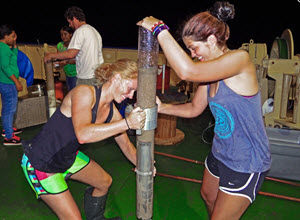
Undergraduate students Nichole Clark (left) and Rachael Kalin (right) transfer a sediment core aboard R/V Justo Sierra. (Provided by C-IMAGE)
The Ixtoc I blowout happened in the Bay of Campeche over thirty-five years ago, so why are scientists studying this spill now? Because understanding what happened to Ixtoc I oil may help predict if and how Deepwater Horizon oil will degrade, persist, and impact northern Gulf of Mexico ecosystems over the next few decades.
A Little Background
The 1979 – 1980 Ixtoc I wellhead erupted in 56 meters of water and released 3.5 million barrels of oil into the southern Gulf of Mexico. This spill is an important historical analog for the more recent Deepwater Horizon oil spill in the northern Gulf. Both spills affected coastal and deep-water biological systems as oil moved through the water column to the sea surface, causing widespread slicks that were treated with dispersants.
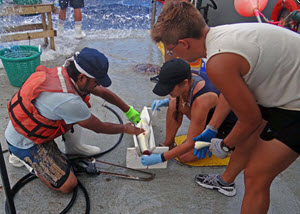
Martín Ramírez, Shannon O’Leary, and Kristina Deak collect samples from a fish caught aboard R/V Weatherbird II. (Provided by C-IMAGE)
In 2015, researchers with the Center for the Integrated Modeling and Analysis of Gulf Ecosystems II (C-IMAGE II) completed two expeditions covering over 11,000 kilometers in the southern Gulf using the R/V Justo Sierra and the R/V Weatherbird II. The team collected sediment cores, water samples, and fish tissues for the first-ever assessment of fish health and sediment contamination across Gulf habitats. This expanded record will provide much-needed baseline information if there are future spills or other environmental events and provides comparative data between Ixtoc I and Deepwater Horizon events.
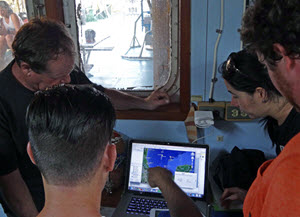
Chief-scientist David Hollander and researcher Isabel Romero discuss R/V Justo Sierra’s anticipated path through the Gulf of Mexico. (Provided by C-IMAGE)
Challenges…
Both expeditions required customs clearance for sampling equipment and permission to collect scientific samples within Mexico’s federally-enforced marine exclusion zone around the Ixtoc-I site. Over thirty researchers from seven countries needed visas and customs clearances prior to departure. Once underway, the teams experienced several unexpected weather events as they traveled long distances to obtain the samples. Principle Investigator Steve Murawski stated:
The collaboration of the US State Department, the Mexican State Department (SRE), the Mexican State oil company PEMEX, and several other agencies was critical to the success of these expeditions.
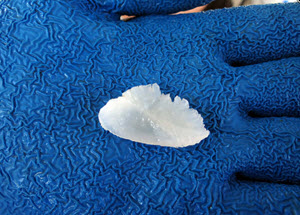
Researchers on the R/V Weatherbird II collected “ear stones” or otoliths (pictured) and other biological materials from fish to gather information about their development. (Provided by C-IMAGE)
…and Successes
Despite complications, the teams exceeded their expedition goals. Researchers collected sediment cores from 70 sites (14 – 3,200 meters depth), including several less than 5 kilometers from the Ixtoc I site and along the western Gulf (south of Texas), Campeche, and Yucatan Peninsula coasts. They collected over 700 fish from 25 stations in Mexico’s territorial sea. Scientists collected almost 5,000 blood, bile, and tissue samples (muscle, liver, fin ray, eye, and otoliths) from dominant Gulf of Mexico species like red snapper and golden tilefish, more than 400 ichthyologic photos, and 22 plankton samples. They also collected water samples from all sediment-coring sites and while in transit from Tuxpan, Mexico, to St. Petersburg, Florida – the Gulf’s longest axis.
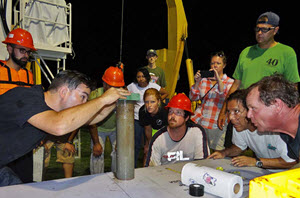
Researchers on the R/V Justo Sierra and crew look on as Patrick Schwing transfers a sample from the sediment corer. (Provided by C-IMAGE)
Cruise coordinator and R/V Justo Sierra co-chief scientist Patrick Schwing commented:
The real success story is how well the science party and the R/V Justo Sierra crew functioned as a team. I am grateful for all the hard hours that everyone worked. By the second site, the entire science team had the deck and laboratory operations down to…well…a science.
Adolfo Gracia, the R/V Weatherbird II’s science lead for Universidad National Autónoma de Mexico, stated:
We can hardly wait to see the findings and compare them with existing data of sediment oil and biological analyses recorded in the Ixtoc I area.
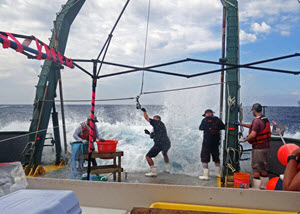
R/V Weatherbird II crew members cast longlines to catch prominent species of Gulf fish for sampling. (Provided by C-IMAGE)
David Hollander, the R/V Justo Sierra chief-scientist, said:
This research has the potential to reveal new and exciting results that provide a better understanding of long-term chemical and ecologic impacts and allow us to better predict the recovery times of impacted benthic environments in the northern Gulf of Mexico.
Preliminary research is already revealing the value of these expeditions. A previous C-IMAGE study discovered evidence that marine snow connected to Deepwater Horizon created a mechanism for oiled particles to reach the seafloor. Initial analyses suggest a similar event may have occurred around the Ixtoc I site and may have affected benthic marine life. Researchers will compare tilefish captured off the Veracruz coastline, the most likely resting place for Ixtoc I oil, to catches near the Deepwater Horizon site and unpolluted areas in the northern and southern Gulf. They can use these data to establish if tilefish experience heavy PAH exposure in the entire Gulf or just near Deepwater Horizon.
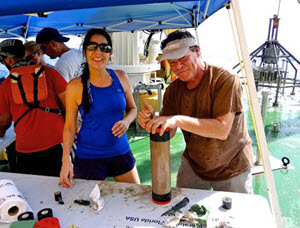
David Hollander and Isabel Romero show a sediment core they collected. The core will be cut open and analyzed to determine the composition of Gulf sediment at different points in history. (Provided by C-IMAGE)
What’s Next?
While C-IMAGE II researchers are still seeking a sample of unweathered Ixtoc-I oil, the samples collected during these expeditions will jumpstart our understanding of this spill. Future analyses will identify chemical and biological changes in the sediment cores, such as shifting redox conditions, changes in benthic meiofauna abundance and diversity, and changes in microbial communities. Researchers will also assess fish stock health by determining PAH compound concentrations in fish and looking for genomic responses and sublethal symptoms related to long-term environmental hydrocarbon exposure. Water samples will provide researchers a rich dataset of water quality, dissolved and particulate organic matter inputs, plankton densities, and concentrations of tiny plastic particles for use in future studies.

Brittany Verbeke removes a sediment core from R/V Weatherbird II’s sampling equipment. (Provided by C-IMAGE)
C-IMAGE’s efforts to uncover new information about fish and oil spill-impacted sediments will help society better understand past spills and better respond to future spills. This research is a significant step toward increased knowledge about the southern and northern Gulf and the Ixtoc I and Deepwater Horizon spill sites. C-IMAGE plans to continue offshore sediment and fish sampling from Mexico through Texas to Louisiana during summer 2016.
Learn More!
These podcasts provide audio stories about this research:
- The Loop Podcast: “The Gulf’s Big Blowouts”
- The Loop Podcast: “Return to Ixtoc”
- Mud, Microbes, and Mammals – Podcasts Take Listeners on Audio Trips through the Gulf
These study summaries provide findings from recent C-IMAGE research:
- Studies Identify Oil Spill Effects in Deep Sea Fish
- Study Finds Concurrent Rise and Fall of Fish Lesions and Oil Contamination
- Study Estimates Carbon, Likely from Deepwater Horizon Spill, in Gulf Sediment
- Study Reveals Oil Spill Changed Oxygen Conditions in Gulf Sediment
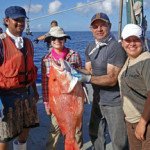
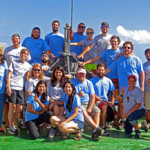
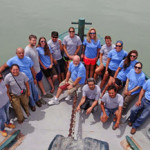
************
This research was made possible in part by a grant from the Gulf of Mexico Research Initiative (GoMRI) to the Center for the Integrated Modeling and Analysis of Gulf Ecosystems II (C-IMAGE II) consortium.
The Gulf of Mexico Research Initiative (GoMRI) is a 10-year independent research program established to study the effect, and the potential associated impact, of hydrocarbon releases on the environment and public health, as well as to develop improved spill mitigation, oil detection, characterization and remediation technologies. An independent and academic 20-member Research Board makes the funding and research direction decisions to ensure the intellectual quality, effectiveness and academic independence of the GoMRI research. All research data, findings and publications will be made publicly available. The program was established through a $500 million financial commitment from BP. For more information, visit http://gulfresearchinitiative.org/.
